Adapted from Larry Carley’s article in Engine Builder
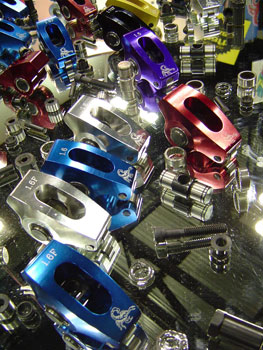 Prime Technology
Prime Technology
The latest developments in lifters, pushrods, rocker arms, valve springs, retainers and valves are pushing the performance envelope to new highs. Parts are getting lighter, stronger and capable of producing more horsepower than ever before.
One of the driving forces behind these advances has been the proliferation of aftermarket cylinder heads that require unique valvetrain components. In addition, new computer-aided design, modeling and manufacturing techniques are making it easier and faster for valvetrain component suppliers to develop new parts in record time. Add to this recent advances in materials science and coatings technology and you can see why engine builders have a much broader range of valvetrain products from which to choose when building a performance engine.
The Valvetrain Diet
Weight is always a major factor to consider when choosing individual valvetrain components. Less weight is almost always better because it lessens the load on the valve springs, and allows the engine to turn more rpm for more top end power.
Every gram of weight reduction in the valvetrain adds 35 to 40 rpm potential to the engine. So, a weight reduction of 10 grams could theoretically add 350 to 400 more rpm to the engine with no other changes to the valvetrain (same springs, etc.).
Yet if valvetrain components are lightened too much, it increases the risk of bending or breaking something. Consequently, you want the lightest possible parts that are still strong enough to handle the valve spring pressures and rpm the engine will generate.
One way to trim weight is to replace steel valvetrain components with ones made from lighter materials such as aluminum or titanium. These include forged or billet aluminum rocker arms, titanium valve spring retainers, titanium valves, even titanium springs.
Aluminum rocker arms typically provide some reduction in weight over stock stamped steel rocker arms, and increased durability. Most have needle bearing fulcrums and roller tips to minimize friction and wear. When the stock steel rockers are replaced with aluminum rockers, the same lift ratio will often add an extra 15 to 40 horsepower due to friction reduction alone. If a higher lift ratio is used, even more power can be squeezed from the engine by increasing the effective lift of the camshaft.
Increasing the lift ratio adds horsepower with little or no loss in low rpm torque, idle quality or vacuum. By opening and closing the valves at a faster rate, the engine flows more air for the same number of degrees of valve duration. High lift rocker arms also reduce the amount of lifter travel needed to open the valves, which reduces friction and the inertia of the lifters and pushrods that must be overcome by the valve springs to close the valves.
By analyzing the stresses and loads on rocker arms with fancy computer programs (finite element analysis), manufacturers are finding new ways to CNC machine out even more weight without sacrificing strength or durability. The result is an even better product that can withstand higher spring pressures and rpm.
Getting the Shaft
Another change that’s taking place in rocker arms today is a move back to shaft-mounted rockers. As spring pressures go up, stud-mounted rockers tend to flex and break.
Installing a stud girdle over the rockers adds extra support and rigidity to the valvetrain, but also interferes with valve adjustments and requires taller valve covers.
Shaft-mounted rockers, by comparison, are stronger because the shaft provides the same kind of rigid support as a stud girdle.
The shaft also holds the rockers in better alignment, eliminating the need for a separate guide plate for the pushrods. This reduces flex in the valvetrain at high rpm for better valve control. The shaft can also supply oil pressure to the rockers to improve lubrication, and reduce friction by lowering the pivot point of the rockers slightly with respect to the valves and pushrods. The improved geometry of shaft-mounted rockers reduces friction between the tips of the arms and top of the valves, and is typically good for an extra 15 to 20 horsepower with no other changes.
One valvetrain component manufacturer we spoke with said high-lift rockers are popular with a lot of people, but that they also are seeing a trend back to lower rocker ratios in some cases. Valve spring suppliers today are offering springs that can deliver up to 500 lbs. of closed seat pressure and 1,500 lbs. of open pressure. So, going with a lower ratio rocker reduces the load on the pushrods, lifters and cam lobes.
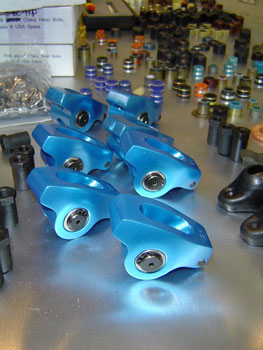 Transposing the Weight
Transposing the Weight
Reducing the weight of the rockers reduces the reciprocating mass of the valvetrain. But, weight reductions on the valve side of the rockers usually has more of an impact on the engine’s rpm potential than weight reductions on the pushrod side. Here’s why: the offset of the rocker arm creates a leverage effect that multiplies weight savings on the valve side by the rocker lift ratio.
For example, on a small block Chevy with a stock rocker arm ratio of 1.5:1, every gram of weight removed on the valve side is worth 150% of any weight savings on the pushrod side. Consequently, cutting 6 grams of weight from the valve side of the valvetrain by using lightweight valve spring retainers or lighter valves has the same net effect as cutting 4 grams of weight from the lifters or pushrods.
Higher rpm require stiffer valve springs and/or multiple valve springs which place greater loads on the rockers, pushrods, lifters and cam lobes. So reducing valvetrain weight means you can achieve the same rpm with less spring pressure, less friction and less wear.
Flexing Your Rods
As spring pressures go up, so does the need for stronger, stiffer pushrods to prevent the pushrods from bending like pretzels. Yet some engine builders and performance specialists are reluctant to use heavier, thickwall pushrods because of the slight increase in weight. As we said earlier, weight on the valve side of the rockers has more of an impact on valvetrain loading and engine rpm than weight on the pushrod side.
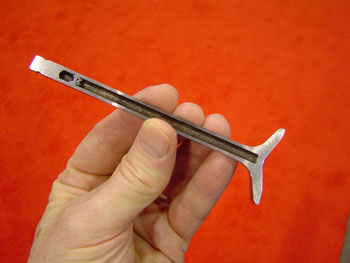 Consequently, the slight increase in weight provided by heavier thickwall pushrods is more than offset by the gains in reliability and valve control they provide.
Consequently, the slight increase in weight provided by heavier thickwall pushrods is more than offset by the gains in reliability and valve control they provide.
Pushrods flex quite a bit at high rpm. Under a strobe light on a Spintron machine, some pushrods behave like a pole-vaulter’s pole.
As the lifter comes up and shoves the pushrod up against the rocker, the pushrod deflects slightly as it overcomes pressure exerted against the rocker by the valve spring. As the valve reaches maximum lift, the deflection in the pushrod snaps back like a spring giving the valve a little extra push.
This can actually cause the valve to open a bit further than it would otherwise, increasing valve lift a bit more than expected. Under controlled conditions this can actually provide a little extra power. But in most instances, pushrod deflection creates harmonics in the valvetrain that disrupt valve timing and control causing a loss of power. It also increases the risk of the pushrod bending or breaking.
The strength of the pushrods can be increased by switching to thicker wall tubing (.060”, .080”, .130”, etc.) and/or by going to a larger diameter or tapered pushrods. But on many engines, the size of the pushrods is restricted by the guideplates on the cylinder head.
A totally different approach has been taken by one manufacturer with its “bimetal” aluminum/steel pushrods. By pressing a special high strength aluminum alloy tube inside a standard .065” wall thickness chrome-moly pushrod, they are able to make the pushrod significantly stronger and 30% to 40% lighter than a comparable thick-wall pushrod — giving customers the best weight to strength ratio of any pushrod on the market.
The special aluminum alloy that the company uses is a proprietary formula with a heat treatment that allows the inner tube alone to support up to 800 psi. When surrounded by the outer chrome-moly tube, the strength of the aluminum/steel bimetal pushrod is three times that of a standard chrome-moly pushrod.
Another feature of the new bimetal pushrod is improved lubrication for the rockers. The inner tube has a hole .090” in diameter that speeds oil flow to the rockers. Where as in a conventional pushrod, the inside is never 100% filled with oil. Instead, there is always 10% to 20% air inside, and the up and down motion of the pushrod aerates the oil.
The tube provides a solid column of oil straight from the lifter to the rocker.
Weight Reduction Tips
Weight on the valve side of the rockers can be reduced a number of ways. One is to use intake and exhaust valves with smaller diameter stems. Another is to use valves with hollow stems, or if your customer has the bucks, to install lightweight titanium valves and valve spring retainers. Titanium valves are typically 40% lighter than steel valves, and titanium retainers are usually half the weight of stock steel retainers (7 grams versus 14 grams).
One of the tradeoffs of switching to lighter materials such as titanium to reduce weight is that titanium is extremely expensive, and is getting more expensive as time goes on. Not everybody can afford valves that cost $90 or more apiece, or retainers that cost $170 a set.
Titanium valve tips and stems are often coated, especially on street applications, to improve lubricity and reduce the risk of stem galling. A steel insert may also be welded or pressed into the tip of the valve to reduce wear, or a hardened steel cap may be used on the end of the valve.
Stem coatings may be plasma spray moly or a similar friction-reducing material, or a thin film coating such as diamond-like carbon (DLC), titanium nitride (TiN), or chromium nitride (CrN) applied by a physical or chemical vapor deposition process. Thin film coatings are lighter than sprayed coatings by up to 4 grams, and do not change tolerances as much. Hard thin film coatings such as diamond-like carbon are only 20 microns thick, yet are extremely durable.
Though titanium valves can be used with cast iron intake seats and nickel-steel exhaust seats, more expensive beryllium copper seats provide the best cooling and durability.
Beryllium copper seats have a yellow or gold appearance, and typically contains about 2% beryllium (though some alloys contain only 0.2% to 0.6% beryllium).
The alloy conducts heat better than steel alloys or cast iron. But beryllium is a toxic metal, so care must be used to avoid inhaling any dust when machining the seats.
For the top class professional racers, the extra cost of titanium is just a cost of doing business and their sponsors will pay for it. But for street racers or the Saturday night racer who pays the bulk of his own expenses, titanium is an exotic luxury – and class rules often prohibit the use of exotic materials on local dirt tracks to keep costs down.
Some manufacturers are now reintroducing redesigned steel parts as a lower-cost alternative to titanium. These include new lightweight steel valve spring retainers, hollow stem stainless steel valves, and even steel exhaust rocker arms.
Hollow stem stainless steel valves are another affordable alternative to titanium valves. The hollow stems are made by drilling out the top two-thirds of the valve stem, micro polishing the inside of the stem to remove stress risers, and welding a hardened tip on the top of the stem. The result is a valve that weighs 20% to 22% less than a conventional stainless steel valve.
The weight reduction is typically good for 300 to 350 more rpm with no other modifications (same springs, rockers, pushrods, etc.). What’s more, the valves are just as durable as conventional valves in naturally aspirated performance engines.
But hollow stem valves may not be recommended for turbocharged or supercharged engines, or ones boosted by nitrous oxide because of the extra heat.
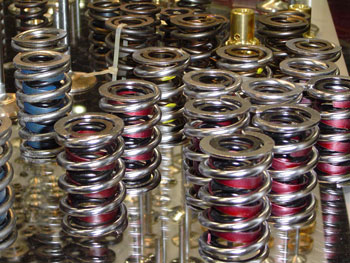 Change Your Springs
Change Your Springs
More weight savings can also be found by replacing conventional valve springs with titanium springs or beehive springs. Like titanium valves and retainers, titanium springs are expensive, but do offer a significant weight savings. Titanium allows the spring not only to be lighter overall, but also to use larger diameter wire with fewer coils. This allows a titanium spring to handle more valve lift without coil bind.
The reduced mass and inertia of a titanium spring increases the natural frequency of the spring to reduce harmonics at higher rpm. Titanium also has a lower torsional modulus than steel which makes it more springy than steel. Consequently, the springs hold their pressure longer and resist taking a set at elevated temperatures. So for high revving performance engines, titanium springs offer some significant advantages.
A more affordable alternative for street engines and budget-minded racers is steel beehive springs. Beehive springs gradually taper towards the top. This reduces the mass in the critical upper half of the spring, and allows the use of a smaller and lighter spring retainer. The shape of the spring also creates a progressive spring rate that alters the spring’s harmonics and allows it to handle higher rpm in many cases without the valve bouncing or floating.
Beehive springs have been popular on the street, and for engines that run single valve springs. But some racers are cautious about using them because there’s no safety margin if a spring breaks. With a double or triple spring, the engine won’t suck a valve if a spring fails.
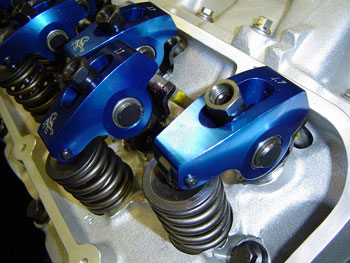 Getting a Lift
Getting a Lift
At the bottom end of the valvetrain, the lifters bear the brunt of the pressure exerted by the springs. Reducing the weight of the lifters is also beneficial for increasing rpm. But another trick that can help high-end power in engines with hydraulic roller lifters is to reduce the distance the plunger travels inside the lifters.
Reducing plunger travel reduces lifter pump up at high rpm. Manufacturers told us that stiffer, heavier pushrods tend to collapse the lifter plungers at higher speeds, so reducing plunger travel within the lifter adds another 200 to 400 rpm to the top end.
Out-Sourcing
Need to look-up a company that manufacturers valvetrain components? Want to e-mail a question to a contact person at a manufacturer or supplier of lifters, pushrods, rocker arms, valve springs, retainers and valves.
Then visit www.enginebuildermag.com/BuyersGuide for easy access to these and hundreds of other manufacturers and suppliers of engine parts and accessories.











